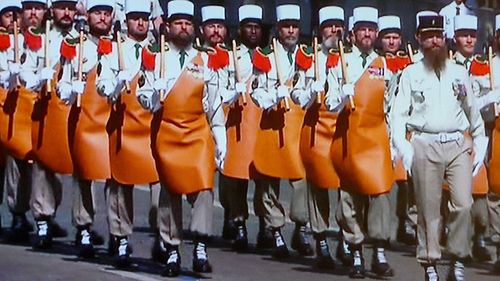
On Wednesday last, Bastille Day I found Síle at the TV watching the march past of the various French armies down the Champs Elysees in Paris.
They were the usual , super disciplined groups of spit and polish troops, marching in exact time like a huge dancing chorus in a Busby Berkley movie.
Then marching to a different drum, a much slower one, came the Sapper Unit (Les Sapeurs) of the French Foreign Legion.
They were wearing harem pants, butchers aprons in leather, leather gloves, carrying axes on their shoulders instead of guns and sporting vast quantities of facial hair.
They were obviously extremely popular as , despite the driving rain, the got the best cheer of all.
Who were they and what did they do and where did they get the name from?
From Wikipedia :
A sapper or combat engineer is an individual soldier who performs a variety of combat engineering duties. Such tasks typically include bridge-building, laying or clearing minefields, demolitions, field defences, and building, road and airfield construction and repair. He is also trained to serve as an infantryman when needed. A modern sapper’s tasks involve facilitating movement and logistics of allied forces and impeding that of enemies.
A sapper, in the sense first used by the Assyrian Army in the early 7th Century BC, was one who excavated trenches under defensive fire to advance a besieging army’s position in relation to the works of an attacked fortification, which was referred to as sapping the enemy fortifications.
Saps were excavated by brigades of trained sappers or instructed troops.
It is interesting to note that despite their not any longer building trenches the modern Fireman in France is called a Sapeur Pompier or a Pumping Sapper

Comments
beth and brian
on July 20, 2010Sapeurs became indispensable in the 17th century in the era of Vauban’s celebrated fortified towns such as Lille and Charleroi on France’s vulnerable northern border. If you wanted to lay siege to a fortification you had to get close. The accepted way was to dig zig-zag trenches which approached the walls obliquely and then batteries of mortars or cannon could be fortified close to the walls and begin to destroy the fortifications of the enemy. Sappers were the hefty lads who could put in the hours of pick and shovel work to dig the trenches and then defend them against surprise sallies by the enemy. Engineers were the officers who supervised and laid out the fortifications, trying not to get too muddy. The whole procedure of siege and counter-siege became an intellectual chess game of great refinement. The vast amounts of treasure spent on fortified towns by the Roi Soleil and his European rivals beggar belief. Les Sapeurs de la Legion Etrangere hark back to this tradition.
padraic
on July 21, 2010I came across a placename as Gaeilge in Kerry recently which was “x….. an tSapaire” – same as Sapeur. Will try and find out what x was and where it’s located.
beth and brian
on July 21, 2010While working on the Archaeological Survey of Co Westmeath in the 1970s I met an old farmer who was curious about our red and white ranging poles and 50m tapes. ‘Are ye from the Sappers and Miners?’, said he, bringing us back in time to the 1840s and the days of O’Donovan and O’Curry.
The comments are closed.